Ijraset Journal For Research in Applied Science and Engineering Technology
- Home / Ijraset
- On This Page
- Abstract
- Introduction
- Conclusion
- References
- Copyright
Healthcare System using AI and Machine Learning
Authors: Harsh Nagar, Ajeet Kumar, Nikhil Kumar, Krishan Mohan Tyagi
DOI Link: https://doi.org/10.22214/ijraset.2025.66240
Certificate: View Certificate
Abstract
Artificial Intelligence (AI) and Machine Learning (ML) are at the forefront of healthcare in scaling innovations in healthcare & medicine as the technology is expanding – helping in screening of large populations for diseases, diagnosis, treatment, and preventive services at individual level. This paper provides a review on the state of several AI technologies in the health domain and its usage in the different areas such as diagnostic and real-time health monitoring and decision support systems. Wearable devices come with compelling artefacts that can improve the accuracy of AI based models like CNN and Random Forest however it shows difficulties with respect to data privacy, scalability and explainability. It gives a broad-scope view on potential research challenges, as well as challenges and barriers, regarding the regulation of AI within current healthcare systems, paving the way for more effective, more accessible and even more equitable solutions.
Introduction
I. INTRODUCTION
Healthcare is one of the first industries to start implementing artificial intelligence (AI) and machine learning (ML) in its internal processes. These systems, however, are far from perfect as they rely largely on treatment that already exists rather than employing preventive measures. But the introduction of AI technology has opened the door to a more advanced approach to medical practice that is centered on preventing diseases rather than treating them. AI through its analytics makes it possible to assess and react to complex situations by targeting the most critical areas such as early detection of diseases, targeted plans for patients at risk and streamlining service provision.
AI has now entered the healthcare ecosystem and with it a plethora of ML applications for medical imaging, patient monitoring, and treatment. Today, diseases such as diabetes and heart disease can be accurately diagnosed with the assistance of ML algorithms such as support vector machines (SVM) and random forests.
In addition, new breakthroughs in convolutional neural networks (CNN) have the potential to dramatically enhance how medical images are analyzed in the future.
However, despite such advances, the use of Artificial Intelligence in the health services still faces challenges that are worrisome. Protection of data is a must, and there is as well, a lack of interoperability, and also, the requirement for AI to be XAI. Legal frameworks such as the General Data Protection Regulation and the Health Insurance Portability and Accountability Act have good intent of bolstering the aspect of data security and privacy, but the challenge of compliance will always remain a major source of challenge for both the developers and providers of services in the health industry.
It goes without saying that AI has the capability of changing the dynamics within the healthcare industry for the better. Utilizing the progress made in data analysis, machine learning as well as computer science, it seems that AI can significantly change the way we approach the diagnosis, treatment and even prevention of diseases. The reality however is that the realisation of such potential is going to be a challenging journey as there exists technical, ethical and regulatory issues that need to be tackled along the way. This paper puts forth the radical perspective in which AI has the potential to reshape the healthcare industry looking at the present day context and its challenges and the way forward. This review seeks to outline recent developments and describe existing inefficiencies with the goal of creating a framework for the future development of AI healthcare solutions.
.
II. LITERATURE SURVEY
The use of AI and ML into healthcare systems has transformed patient care, diagnosis, and operational efficiencies.
A. Applications of AI and Machine Learning in Smart Healthcare
AI and machine learning have a wide range of applications in healthcare, including disease prediction, medication discovery, and medical imaging. Rahman et al. (2024)[2] emphasize the use of deep learning (DL) to analyze complicated medical data such as Electronic Health Records (EHRs), wearable technology, and clinical imaging. Although promising, obstacles such as data scarcity and variability persist.
B. Transforming Healthcare Operations with AI
The significance of AI in enhancing hospital operations and clinical decision-making is underscored by Maleki and Forouzanfar (2024)[1] as they highlight AI's role in transforming healthcare. They demonstrate how AI has the potential to enhance diagnostic accuracy, optimize the allocation of resources, and facilitate personalized medicine through the utilization of advanced algorithms such as convolutional neural networks (CNNs) and transformers for image analysis and natural language processing.
C. Challenges and Systemic Issues
The implementation of AI-driven healthcare innovations faces various obstacles, including limited resources, slow adoption rates, and ethical concerns. Apell and Eriksson (2023)[5] utilize the Technological Innovation Systems (TIS) framework to examine these barriers, identifying the necessity for improved resource mobilization and systemic synergy. They propose policy interventions to align innovation objectives with healthcare requirements.
D. Integration of AI with Healthcare Technology
The studies underscore the integration of AI into existing healthcare infrastructures, emphasizing its potential in areas like:
- Medical Imaging: Enhancing accuracy and reducing diagnostic errors
- Wearables and monitoring: Revolutionizing
- Drug discovery: Accelerating timelines through predictive analytics??.
E. Future Directions
Key areas for future development include:
- Developing robust, scalable AI models to handle diverse data.[4]
- Addressing ethical issues like privacy and algorithmic bias.[3]
- Enhancing interdisciplinary collaboration among technologists, clinicians, and policymakers??.[3]
Table summarizing the key findings and gaps identified in the sources
|
Key Findings |
Gaps |
|
AI is transforming disease detection, hospital operations, and patient care. Examples include AI algorithms for diagnosis, AI-powered wearables, and virtual nursing assistants. The review emphasizes the need to address ethical considerations in AI integration. |
Future research should focus on AI systems that can handle diverse datasets and reduce biases. Need for integration of AI with traditional diagnostic methods and enhanced interdisciplinary collaboration. |
|
Clinicians identify five key areas for AI application in EHRs: predictive analysis, clinical decision support, data visualization, NLP, and patient monitoring. Technical limitations related to language processing and context-specific reasoning are recognized. |
Need for government strategies to ensure responsible and transparent AI application, addressing medico-legal challenges and mitigating potential biases and inequalities. |
|
Participants express high expectations for AI in improving hospital administration, quality of care, and reducing disparities. Concerns focus on potential changes to healthcare practices, loss of autonomy, and data management risks. |
Further research needed to explore the views of a larger and more diverse patient population. Lack of infrastructure and support for Patient and Public Involvement in AI development in Japan. |
|
ML and DL have the potential to support intelligent healthcare, particularly in areas such as disease prediction, drug discovery, and medical image analysis. The survey highlights the integration benefits and applications of these technologies. |
Need to address challenges related to algorithm design, data-driven hyperparameter learning, model optimization, and data representation. Future research should focus on developing "Future Generation ML-DL Modeling" and mitigating potential security and privacy risks. |
|
Limited market knowledge and experience with AI healthcare technology innovations among industry actors. Insufficient understanding of AI's potential impact among decision-makers. Difficulties using health data due to privacy and liability concerns. |
Need for policy interventions to address system-blocking mechanisms, including resource mobilization and guidance of search. Further research needed on AI innovations developed within healthcare organizations. |
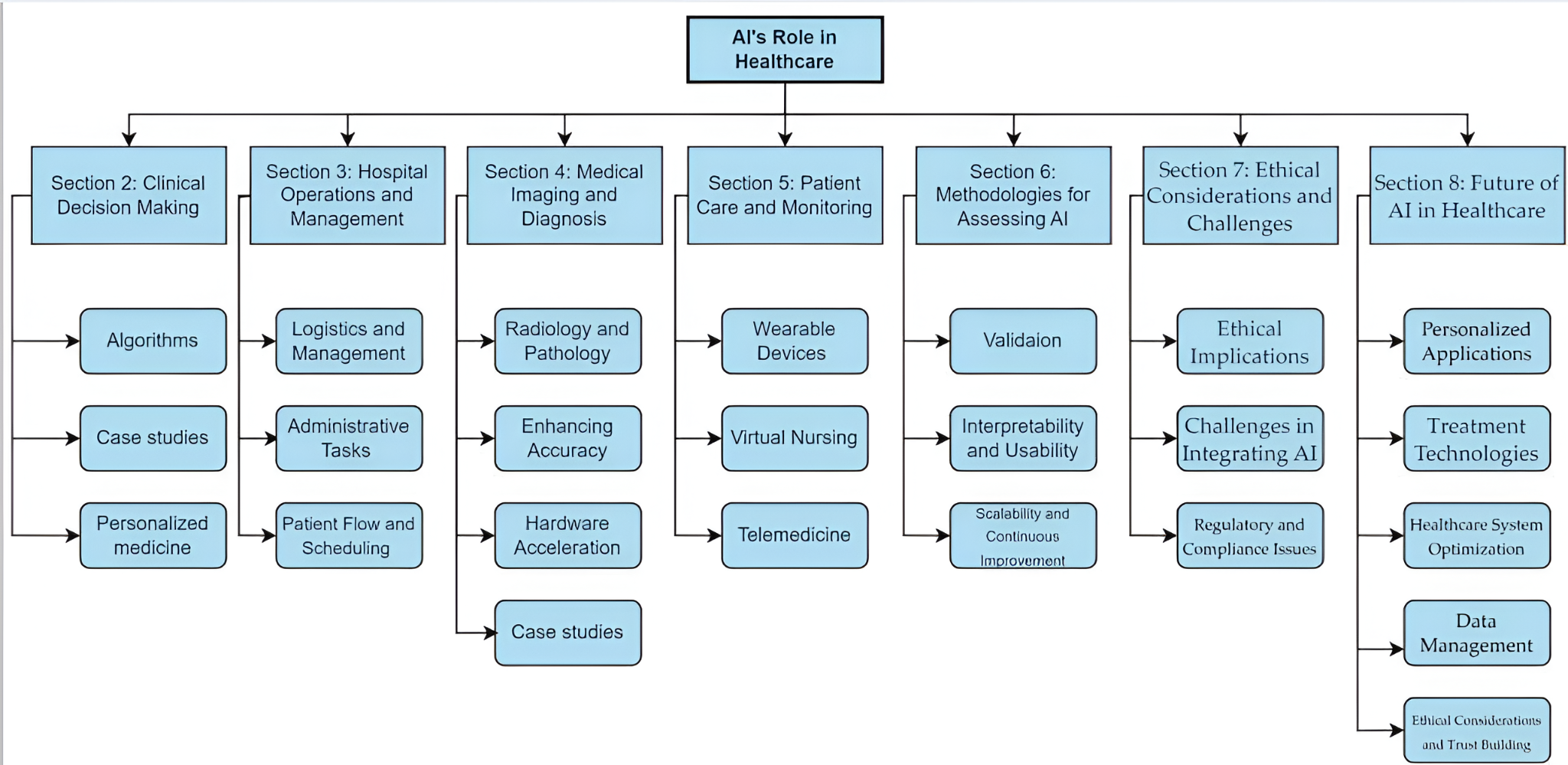
. Fig.1 Comprehensive overview of AI applications in hospitals and clinics
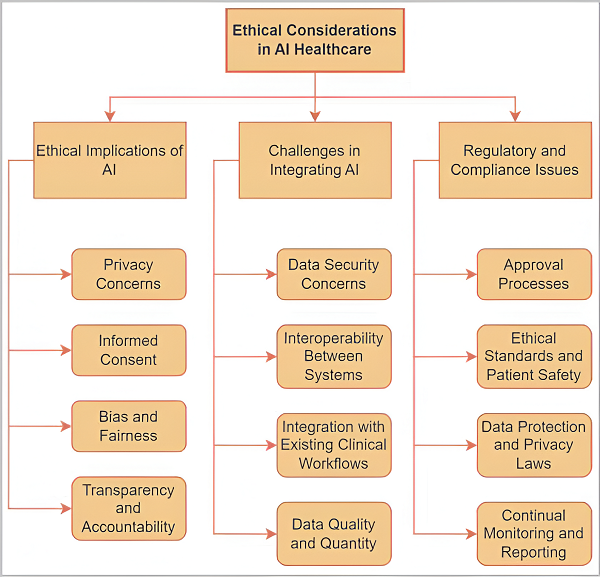
Fig.2 Navigating ethical considerations and challenges in healthcare AI
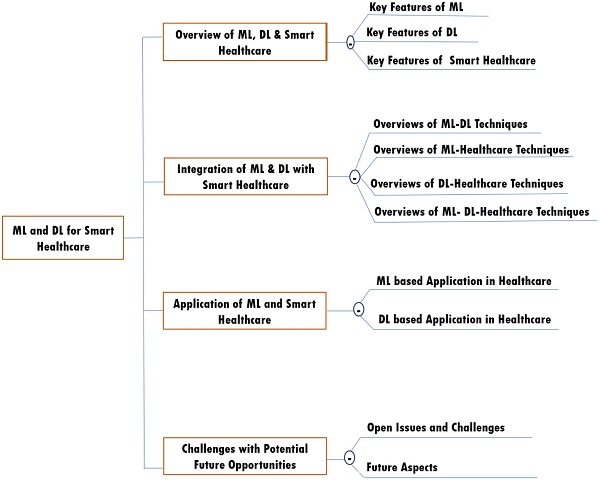
Fig.3 Road-map of this paper
III. PROPOSED WORK
This project proposes a healthcare platform that powers AI and machine learning that integrates real-time health monitoring along with personalized recommendations, proactive disease management, and managing chronic diseases such as diabetes and cardiovascular conditions. Key Objectives of the project:
- Accurate Disease Diagnosis: Improve the accuracy of diagnostics with the help of advanced algorithms such as Random Forest and Support Vector Machines (SVM).
- Daily Health Monitoring: Enabling real-time tracking of user health parameters and generating personalized recommendations for healthier lifestyles.
- Transparency in AI: Using Explainable AI (XAI) methodologies to make predictions and recommendations interpretable to both users and healthcare providers.
- Scalability and Adaptability: Design a robust platform architecture that can handle diverse datasets and accommodate a growing user base.
- Data Security and Privacy: Ensure that data protection standards such as HIPAA and GDPR are maintained and the user's data is secured.
A. Approach or Methodology
The work will utilize the following approaches to deliver the proposed objectives:
- Machine Learning Algorithms
- Random Forest and SVM for disease diagnosis with high precision.
- Feature selection methods such as mRMR (minimal-redundancy-maximal-relevance) to extract most relevant features.
- Daily Monitoring Tools
- Incorporation of daily alerts that track the level of activity, vital signs, and diet patterns
- The AI models will work on processing the data using frameworks such as TensorFlow and scikit-learn.
- Scalable Cloud Infrastructure
- Employ cloud services like AWS or Google Cloud to manage and process large-scale healthcare datasets.
- Data Privacy Measures
- Use advanced encryption methods and comply with global data regulations to secure sensitive health information.
B. System will follow the 5 step process
Data Collection
The application gathers health information from users such as symptoms, diet, and physical activity, heart rate, blood pressure, activity level, sleep patterns, and many more.
Data Preprocessing
Raw data is cleaned and prepared for analysis. This includes handling missing values, normalizing numerical values, and removing outliers. Data is organized into a structured format suitable for feeding into machine learning models.
AI Model Processing
The cleaned and processed data is passed to the machine learning algorithms, such as Random Forest, Support Vector Machines, or k-NN. The models of the platform are pre-trained with large datasets to identify the patterns in health indicators regarding chronic diseases like diabetes, hypertension, etc. The AI model gives a diagnosis or classification, such as "High Risk for Diabetes" or "Normal Health Status."
Insights Generation and Recommendations
According to the diagnosis test carried out, the website will deliver recommendations to enhance the user's health to improve the lifestyle conditions, medication recommendation, or additional diagnostic tests. Recommendations will be made available on a user-friendly dashboard or notification.
Data Storage
Data is secured in a cloud-based database with encryption which can be utilized for future analysis, thereby allowing constant monitoring and adjustment of recommendations.
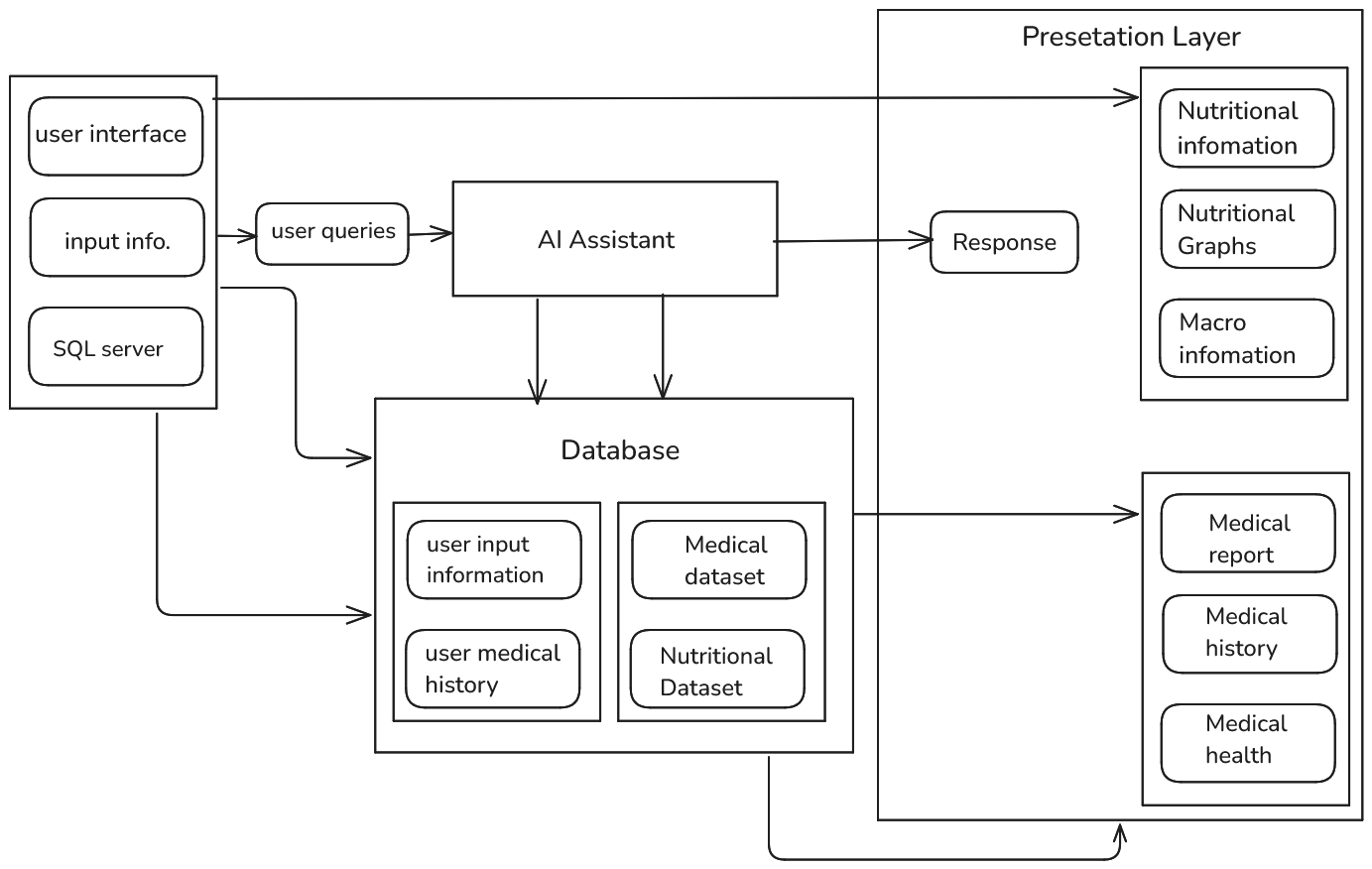
Fig.4 System Architecture Diagram
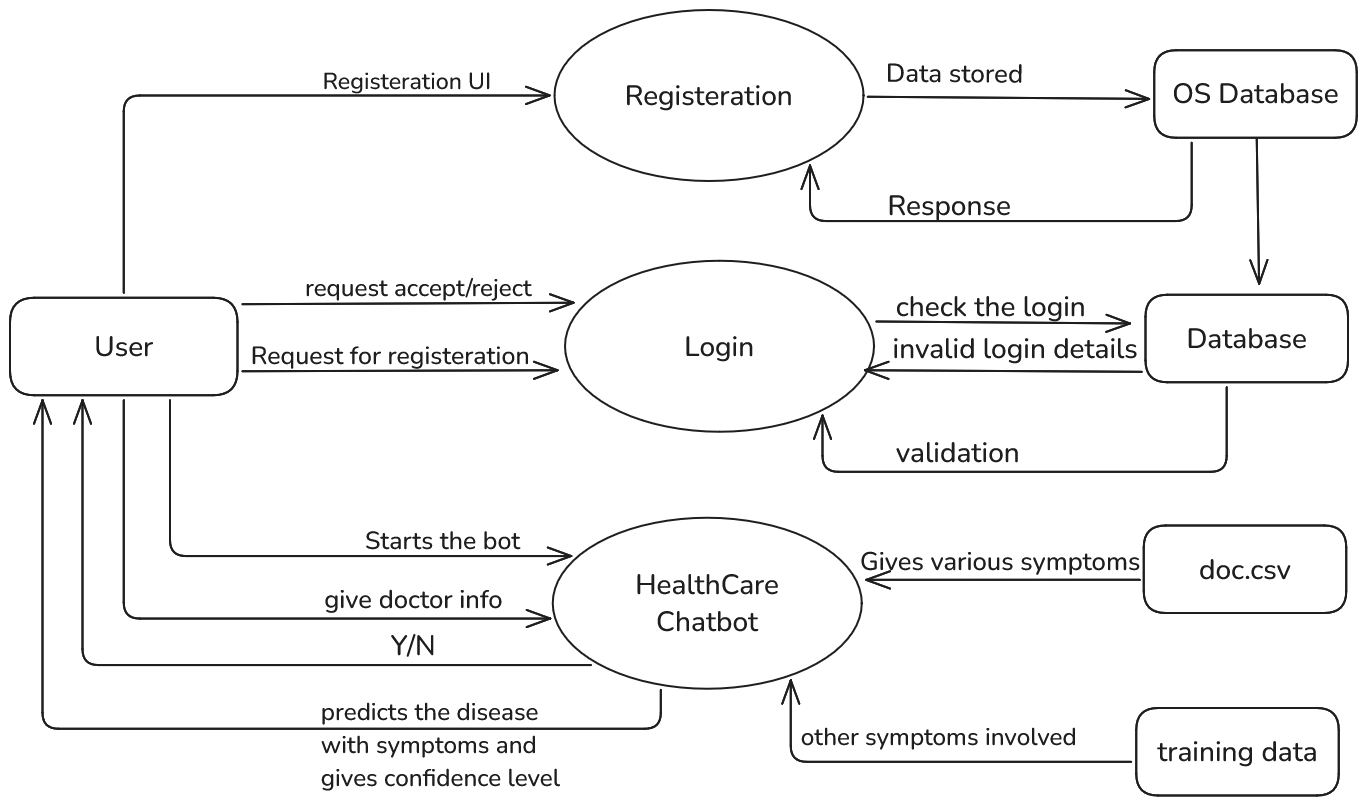 Fig.5 Case Diagram of the system
Fig.5 Case Diagram of the system
Conclusion
From an AI and ML standpoint, these technologies are poised to transform healthcare by providing data-driven answers to major problems. AI and ML have significant potential in healthcare. They can use complex medical data to improve disease detection and diagnosis, expedite hospital operations, and tailor patient treatment and monitoring. 1) High-quality, diversified, and easily available data is critical. This includes overcoming data sharing barriers while respecting privacy and addressing data biases to achieve equitable healthcare results. 2) AI technologies must be easily integrated and user-friendly to both clinicians and patients. Human-centered design and explainable AI (XAI) are critical to achieving integration and establishing confidence. 3) Continuous innovation is necessary. Future research should concentrate on creating more stable and generalizable AI models, investigating novel data augmentation approaches, and integrating AI with future technologies such as the Internet of Medical Things (IoMT).S
References
[1] Maleki Varnosfaderani S, Forouzanfar M. The Role of AI in Hospitals and Clinics: Trans-forming Healthcare in the 21st Century. Bioengineering (Basel). 2024;11(4):337. Published 2024 Mar 29. doi:10.3390/bioengineering11040337 J. Clerk Maxwell, A Treatise on Electricity and Magnetism, 3rd ed., vol. 2. Oxford: Clarendon, 1892, pp.68–73. [2] Rahman A, Debnath T, Kundu D, et al. Machine learning and deep learning-based approach in smart healthcare: Recent advances, applications, challenges and opportunities. AIMS Public Health. 2024;11(1):58-109. Published 2024 Jan 5. doi:10.3934/publichealth.2024004. [3] Katirai A, Yamamoto BA, Kogetsu A, Kato K. Perspectives on artificial intelligence in healthcare from a Patient and Public Involvement Panel in Japan: an exploratory study. Front Digit Health. 2023 Sep 13;5:1229308. doi: 10.3389/fdgth.2023.1229308. PMID: 37781456; PMCID: PMC10533983. . [4] Alanazi A. Clinicians’ Views on Using Artificial Intelligence in Healthcare: Opportunities, Challenges, and Beyond. Cureus. 2023 Sep 14;15(9):e45255. doi: 10.7759/cureus.45255. PMID: 37842420; PMCID: PMC10576621. . [5] Apell, P. and Eriksson, H.(2021) ‘Artificial intelligence (AI) healthcare technology innovations: the current state and challenges from a life science industry perspective’,Technology Analysis & Strategic Management, 35(2).
Copyright
Copyright © 2025 Harsh Nagar, Ajeet Kumar, Nikhil Kumar, Krishan Mohan Tyagi. This is an open access article distributed under the Creative Commons Attribution License, which permits unrestricted use, distribution, and reproduction in any medium, provided the original work is properly cited.

Download Paper
Paper Id : IJRASET66240
Publish Date : 2025-01-02
ISSN : 2321-9653
Publisher Name : IJRASET
DOI Link : Click Here
 Submit Paper Online
Submit Paper Online

